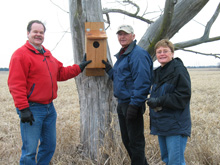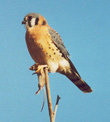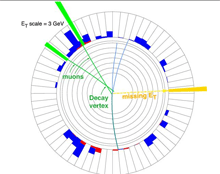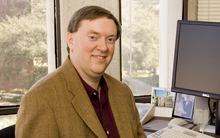 |
Thursday, March 2
11:00 a.m.
Academic Lecture Series -
Curia II
Speaker: S. Parke, Fermilab
Title: The New World of Neutrino Physics – Part II
(4th Lecture)
2:30 p.m.
Theoretical Physics Seminar -
Curia II
Speaker: C. Anastasiou, ETH Zurich
Title: LHC Physics and Challenges for Perturbative Methods
3:30 p.m.
DIRECTOR'S COFFEE BREAK -
2nd Flr X-Over
4:00 p.m.
Accelerator Physics and Technology Seminar (NOTE LOCATION) -
Curia II
Speaker: K. Ohmi, KEK
Title: Discovery and Mitigation of the Electron Cloud at KEK
Friday, March 3
3:30 p.m.
DIRECTOR'S COFFEE BREAK -
2nd Flr X-Over
4:00 p.m.
Joint Experimental Theoretical Physics Seminar -
1 West
Speaker: G. Borissov, Lancaster University
Title: B Physics Results with 1 fb-1 from DZero
*** Announcement ***
On Monday and Tuesday, March 6 and 7, there will be a workshop on Long Baseline Neutrino Experiments
more information
|



Thursday, March 2
-Santa Fe Black Bean
-Sloppy Joe
-Stuffed Peppers
-Sauteed Liver & Onions
-Baked Ham & Swiss on a Ciabatta Roll
-California Pizza
-Crispy Fried Chicken Ranch Salad
Wilson Hall Cafe Menu
|
 |
Thursday, March 2
Dinner
BOOKED
Wednesday, March 8
Lunch
-Calzone of Spicy Sausage
-Roasted Red Peppers and Three Cheeses
-Cesar Salad
-Hazelnut Cake w/Coffee Ice Cream and Bittersweet Mocha Cake
Chez Leon Menu
Call x4512 to make your reservation.
|


|
 |
Kestrels Can Soon Call
Fermilab Even Nicer Home
|
 |
| Bill Wickenberg (left) and volunteers Bob Mathieu and Evalyn Campbell display one of the several American kestrel nest boxes to be located onsite. |
|
The American Kestrel, one of the most common raptors found in North America,
 |
| American Kestrel |
is a small reddish-brown falcon that thrives in several different habitats, including the woodlands and open fields of Fermilab. Soon lab kestrels will find nearly half a dozen nest boxes onsite where they can roost and raise their young this summer.
Kestrels are currently known to nest onsite in several locales, mainly under the eves of buildings. Local residents Bob Mathieu and Evalyn Campbell, who were already volunteering with Accelerator Division building manager Bill Wickenberg to help maintain the lab's 50 bluebird nest boxes, soon took notice of these colorful raptors. Mathieu asked if kestrel nest boxes could be put up at the lab as well, and over the winter, built several of them. Wickenberg and the volunteers have been careful to choose nest box locations away from where current kestrel nests exist, to avoid disturbing the birds.
The volunteers have already installed one kestrel nest box and installation of the others is in progress. "It's a slow process," explains Wickenberg. While scouting potential sites for boxes, they also must keep in mind things like the fall prairie burn schedules and possible kestrel territorial ranges. Nonetheless, the volunteers are optimistic about providing the new nest boxes. "My family moved to Warrenville in 1935, when it was 300 people, and this was all farmland," says Mathieu. He recalls seeing kestrels, mockingbirds, bluebirds, red-tailed hawks, and Cooper's hawks, in the area. "As far as kestrels interfering with or eating other birds, I've never seen them do it," he says. "Their main diet is mice and insects."
— Dawn Stanton
|

The Future of Digital Data
|
Over the last few decades, advances in
 |
| Francine Berman |
information technology have led to a fundamental change in research and education, and digital data collections are at the heart of this change. These collections are rapidly multiplying in number and increasing in size, and their management, preservation and use was the focus of the "Expanding Universe of Digital Data Collections" symposium at the 2006 American Association for the Advancement of Science Annual Meeting.
Read More
|

Interactions.org,
February 28, 2006:
Marburger, Bement, Orbach to address High Energy Physics Advisory Panel Friday, March 3, in Washington
Chicago—Science Advisor to the President and Office of Science and Technology Director John H. Marburger; National Science Foundation Director Arden L. Bement; and Department of Energy Office of Science Director Raymond L. Orbach will all address a meeting of the DOE/NSF High Energy Physics Advisory Panel on Friday morning, March 3, at the Latham Hotel, 3000 M Street, Washington DC.
The March 3 HEPAP meeting is the Panel’s first under incoming Chair Melvyn J. Shochet, professor of physics at the University of Chicago, and with a new HEPAP membership.
Read More
|
|
 |

|
A novel search for long-lived new particles with DZero |
 |
| Simulation of the production of a pair of neutral, long-lived
particles with the subsequent decay of one of them to two muons and a neutrino within the Dzero central tracking region. (Click on image for larger version.)
|
|
|
Many of the greatest advancements in our understanding of particle
physics have come from unexpected discoveries of new particles. For
this reason experiments at Fermilab often look for the
unknown. The DZero experiment has recently expanded its abilities
by looking for low-mass, neutral, long-lived particles decaying to two muons. Such particles could be signals for supersymmetry and also possibly explain an intriguing, unexplained, and similar signal from NuTeV.
To search for long-lived particles, DZero fits pairs of muons to a common
vertex (assumed to be the decay position of a hypothetical particle)
and measures the distance from the point of the primary interaction. This separation is a measure of a particle's lifetime.
Previous analyses used decays which have millimeter separation, while
for this analysis, we search for decays at least 5 centimeters away
from the primary interaction. The "K-short" meson is an example of an already known low-mass particle with long lifetime that decays within the detector to two pions. By studying K-short mesons we demonstrated our ability to reconstruct neutral particle decays at centimeter displacement.
DZero finds no muon pair events with a vertex in the search region. This result is consistent with background expectations. Together
DZero and NuTeV rule out at least one explanation of the NuTeV excess as a signal of supersymmetry.
|

|
| Above: Todd Adams (Florida State University) worked on this analysis. Below: Leo Bellatoni, Paul Rubinov and Jadwiga Warchol are members of the
team working on an upgrade of the analog front end readout
boards (AFE-IIt) for the DZero fibre tracker. This upgrade will be essential to
ensure the continued excellent performance of the DZero tracking
system at the very high luminosities expected in Run 2b of the Tevatron. (Click on images for larger version.)
|
|
Result of the Week Archive
|

|
Particle Physics Workshop,
Live from Italy
The 20th anniversary
of the annual particle physics workshop, Les Rencontres de Physique de la Vallee d`Aoste, will be held at La
Thuile, from March 5 to 11. A special anniversary session will
run from 10:00 to 11:30 a.m. and from 4:00 to 6:00 p.m. (local Italian time)
on Monday, March 5. The distinguished speakers will be Rocky Kolb,
Carlo Rubbia, Roberto Petronzio, Samuel C.C. Ting, Sheldon Glashow and
Alvaro De Rujula. The titles of their talks can be found in the
preliminary program at the conference
web site. Streaming video will be available here.
Bike to Work
With the warmer weather just around the corner, it'll soon be time to start biking to work! Connect with fellow cyclists, get tips, weather conditions and find out how much gas is saved when you opt to cycle here.
Upcoming Activities
|
|








